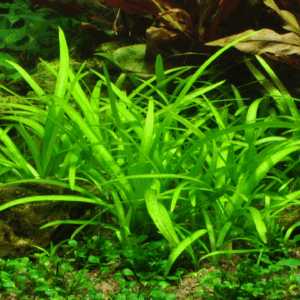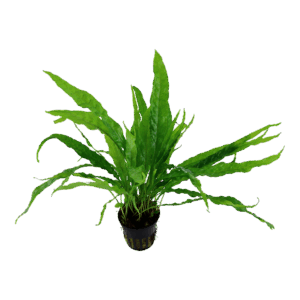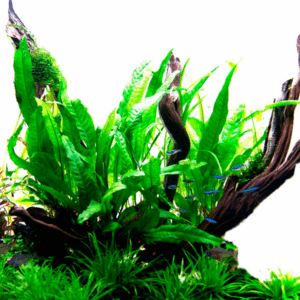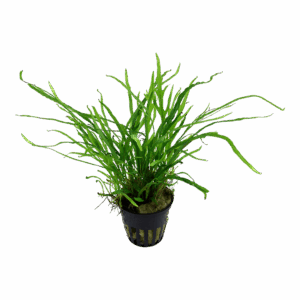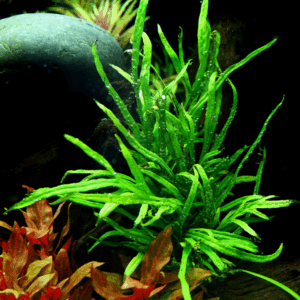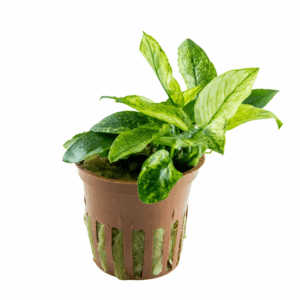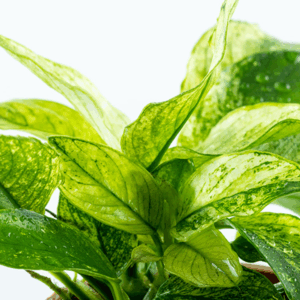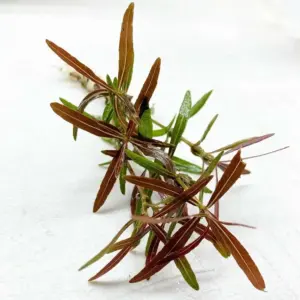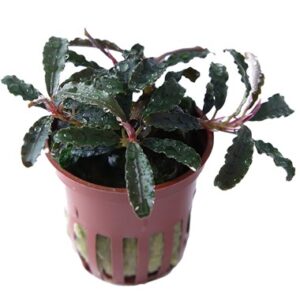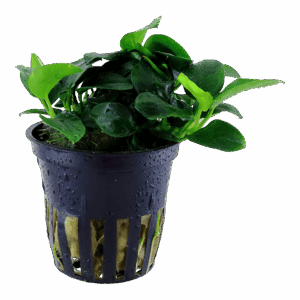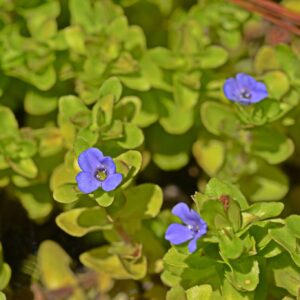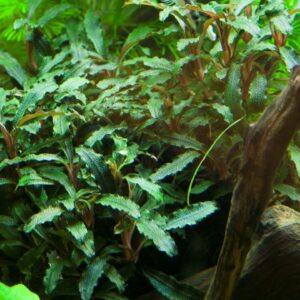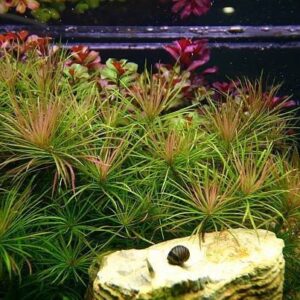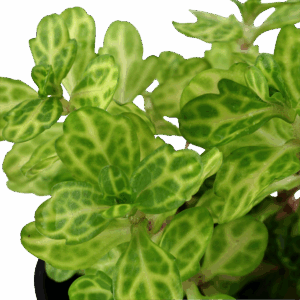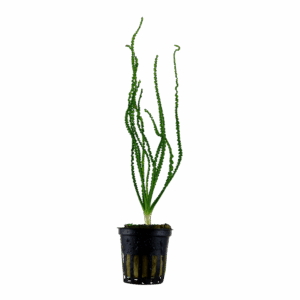Tropica Sagittaria Subulata
Tropica Sagittaria subulata from South America is an ideal, undemanding foreground plant whose short runners form a compact group. Place individual plants 2-4 cm apart. This plant may cause problems because in certain conditions it suddenly grows to a height of 50 cm when it grows older. But if it is then moved into the background it may become low again. In the aquarium, it sometimes sends a long flower stem to the surface, and small white flowers unfold just above the water surface.
Tropica Java Fern Microsorum pteropus
Tropica Java Fern Microsorum pteropus is a water fern from Asia, 15-30 cm tall. To be grown on a root or stone, attached with fishing line until it has gained a hold. If planted in the bottom, do not cover the rhizome because it will rot. Easy to propagate by splitting the horizontal rhizome. A hardy plant that grows in all conditions. The black spots under the leaves are sporangia (reproductive organs), not signs of disease, as many believe.
Tropica Microsorum pteropus Trident Java Fern
Microsorum pteropus or Java fern is from Asia. Tropica Microsorum pteropus Trident Java Fern is a narrow-leaved, smaller form of Microsorum, which like other Microsorum is an easy and safe plant. ’Trident’ is both suitable for beginners, as well as the experienced scaper, and fits both smaller and larger aquariums. The name ’Trident’ tells that the plant leafs are tripartite, while the leaves can vary from whole to multipartite. Suitable for planting on stones or tree roots. When planted on the bottom layer, avoid covering the horizontal stalk. New, small plants are often created on the leaf tips, and can carefully be pulled off and planted.
Tropica Anubias barteri var. nana ’Pinto’
Anubias 'Pinto' is an exquisite selected cultivar of Anubias barteri. Its leaves, measuring 3-6 cm, showcase captivating patterns of white, light green, and dark green. These patterns can vary depending on the environment, and under certain conditions, the plant may develop entirely dark green leaves. Achieving the perfect balance of light is crucial as good lighting enhances the white patterns, but excessive light can lead to damage and algae issues. With slow growth, Anubias 'Pinto' is a plant that demands patience. It can be beautifully incorporated into aquascapes by attaching it to rocks or wood in the aquarium. However, it is essential to remember never to cover the rhizome, as this can result in rotting and the plant's demise. Unveil the enchanting allure of Anubias 'Pinto' as it adorns your aquascape with its captivating blend of colors and intricate leaf patterns. Strike the perfect balance of lighting, and watch as this cultivar flourishes, becoming the centerpiece of your aquatic paradise.
Kaiser Aquatics Hygrophila Lancea Araguaia
Quick Facts
-
Scientific Name: Hygrophila Lancea ‘Araguaia’
-
Common Name: Hygrophila Araguaia
-
Family: Acanthaceae
-
Origin: Araguaia River, Brazil
-
Light Requirement: Medium–High
-
CO₂ Requirement: Recommended
-
Growth Rate: Moderate
-
Placement: Midground
-
Temperature Range: 22–28 °C
-
pH Range: 6.0–7.2
-
Propagation: Stem cuttings or side shoots
-
Difficulty Level: Intermediate (Medium)
Tropica Bucephalandra 'Kedagang'
The ‘Kedagang’ is a variety of the Bucephalandra family originated in Borneo. It is characterized by long, narrow, dark green leaves with white dots. The leaf can be 1-2 cm wide and up to 6 cm long. The rhizomes are red and similar to the Red variety of Bucephalandra. When immersed, a blue metallic shade may appear on the leaves.
Tropica Anubias barteri ’Coin Leaf’
Anubias 'Coin Leaf' is a captivating cultivar of Anubias barteri. With its nearly circular leaves, measuring 4-6 cm in diameter, and a rich deep green color, this variant stands out. Its growth is slow and creeping, making it an ideal choice for aquarists seeking low-maintenance plants. Thriving in relatively low light, Anubias 'Coin Leaf' is an easy-to-grow plant that adds a touch of elegance to any aquarium. It can be placed on rocks or wood within the tank, but if planted in the substrate, take care not to bury the rhizome. Burying the rhizome can lead to rotting and the plant's demise. Discover the beauty of Anubias 'Coin Leaf' as it enhances your aquatic garden with its circular leaves and vibrant green hue.
Tropica Anubias Barteri 'Petite'
Anubias sp. ‘Petite’ is a mutation which appeared in cultivation at the Oriental aquarium plant nursery in Singapore. Stays less than 5 cm tall, has very small leaves and a rhizome of 5-10 cm or more from which the leaves will grow. Branches well and creates dense groups. Undemanding like the other Anubias and does not appreciate high light intensity either. It is most decorative when attached to stones or roots, and like other Anubias it should be attached with fishing line until it gains a hold. If planted in the bottom, do not cover the rhizome as this may cause the plant to rot and die. An ideal plant for miniature landscapes in small aquariums but will also attract attention in larger tanks.
Kaiser Aquatics Bacopa caroliniana
Bacopa caroliniana also known as Lemon Bacopa is a hardy, slow‑growing stem plant that works equally well in aquaria, paludaria, and shallow pond margins. Below is a quick‑reference sheet followed by deeper care notes and pro tips.
Tropica Bucephalandra sp. 'Red'
The Bucephalandra resemble Anubias very much and should be treated the same way. They usually grow more or less epiphytic in or near water. Bucephalandra sp. 'Red' does best at lower light levels and is very easy to grow. The leaves are of a very dark green or leathery red colour. Numerous tiny, white dots and sometimes a faint, metallic, blue colour will appear on submerse leaves. Size of leaf is 2-4 cm wide, 4-6 cm long and usually it will present wavy edges. Do not cover the creeping rhizome when planting. This will cause the plant to rot and die.
Tropica Anubias barteri var. nana
Tropica Anubias barteri var. nana is a small, attractive plant that thrives in all conditions. It originates from Cameroon and will reach 5-10 cm height. The rhizome will be 10-15 cm or more. It grows slowly, and the leaves survive for several years, giving slow-growing algae the chance to become established. The best result is achieved by planting on a stone or tree root. Fishing line can be used to attach the plant until it gains a hold. If planted on the bottom the rhizome must not be covered because it tends to rot. It flowers frequently under water and will thrive in shady places, where other plants will not. It is not eaten by herbivorous fish.
Tropica Shinnersia rivularis ‘Weiss-Grün’
Variety of Shinnersia rivularis, distinguished by the white veins on the leaves, 30-60 cm long and up to 10 cm wide stems. This colour mutation was discovered at the Dennerle aquarium plant nursery. The plant grows rapidly and soon reaches the water surface, but shoots can simply be pinched off and planted back in the bottom. Shinnersia does not appreciate high temperatures. It tends to become leggy, but several plants placed in a group, will improve the appearance. The colours will develop optimally at good light conditions.
Tropica Micranthemum Umbrosum
Micranthemum umbrosum is a beautiful plant from US with small round leaves. It is suitable for small or large aquariums with stems becoming 10-25 cm long and 1-2 cm wide. Relatively demanding in terms of light. CO2 addition will promote growth. Once the plant starts growing, it grows fast, and the shoots need to be pinched out often (can be planted as cuttings in the soil). Most beautiful in groups of many stems.
Tropica Crinum calamistratum
Crinum calamistratum from West Africa is a very graceful bulbous plant with dark-green, very narrow leaves. The curly leaves becomes 40-120 cm long. It forms smaller bulbs than the other Crinum-species, and requires less light. In the aquarium plants that are thriving form a number of small bulbs. It is not eaten by herbivorous fish. It can also be used in brackish aquariums with low salt concentrations.



